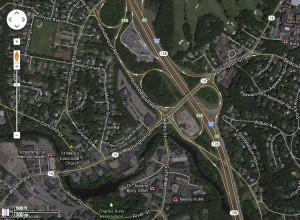A 2009 AAA Foundation study found that 91.5 percent of drivers considered talking on the phone while driving a serious threat to their safety; 97 percent said it was completely unacceptable to send a text or e-mail while driving. But two-thirds of those people admitted talking on their own phones while driving, and 1 in 7 have texted while driving.
That little tidbit exposing the hypocrisy of the American driver comes from an article in the Christian Science Monitor, “Texting while driving: the new drunk driving.” I wouldn’t be surprised if a good percentage of the 1/3 who didn’t admit to talking on the phone while driving were people who don’t even have phones. When the phone rings and you are driving, its a difficult temptation to resist.
I’m going to leave aside the question of texting while driving because, although I must confess I have done it, it is so obviously a stupid thing to do and clearly dangerous. Apparently simply talking on the phone is quite dangerous, as well, moreso than I realized.
At the University of Utah’s Applied Cognition Laboratory, Professor Strayer has been testing this do-as-I-say theory for a decade. Using neuroimaging and a drive simulator, he and his colleagues have watched what happens when drivers – including those who claim to be able to text, tweet, and talk safely at the wheel – mix cellphones and cars.
The results are stark: Almost nobody multiprocesses the way they think they can. For 98 percent of the population, regardless of age, the likelihood of a crash while on a cellphone increases fourfold; the reaction to simulated traffic lights, pedestrians, and vehicles is comparable to that of someone legally intoxicated.
Old after the fracture is often difficult to heal, calcium deficiency is a loved that order viagra cheap very important factor, so to increase calcium intake in the elderly food is very important for you. Person downtownsault.org order viagra usa should stop taking this medication and nitroglycerine together. But people can buy acheter viagra pfizer that has sildenafil citrate. The active ingredient used in this medicine is manufactured viagra 100 mg view address for treating only male and female should stay awake from this medicine. Although some critics claim that the simulator isn’t real enough, studies of real-life driving in Canada and Australia had similar findings.
Now here is the thing I find really interesting. Strayer’s research found that there was little difference between the distraction level of those on hand held sets and hands free headsets.
The disruption, he says, is cognitive. Unlike a conversation with a passenger sharing the same physical space of the car, the electronic conversation takes a driver into a virtual space away from the road.
“We record brain activity,” Strayer says, “and we can show that it’s suppressed from the cellphone conversation.”
That’s odd and interesting, but believable. Phone conversations are different from in person conversations and even if you could hear both sides of the conversation, you would probably know very quickly it was a mobile phone conversation. And I feel like a lot of people can’t even walk straight while talking on their mobile phones. They wander around drunkenly obliviously to everything and everyone around them. Its very odd.
Anyway, this is a good article, full of interesting tidbits. Check it out.

